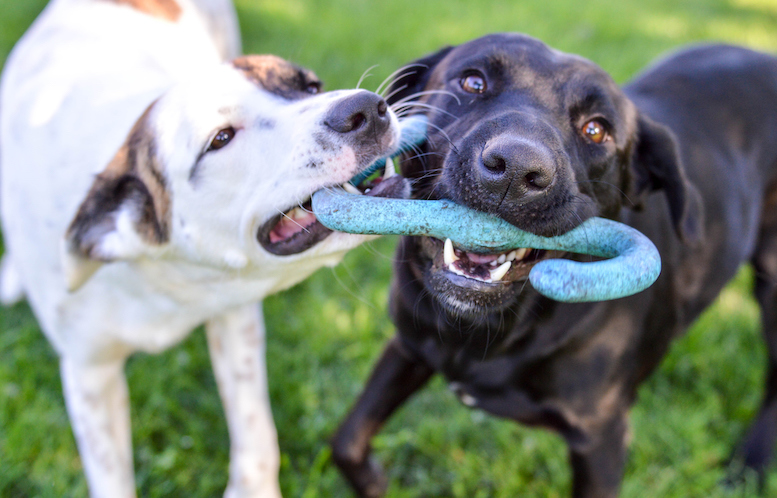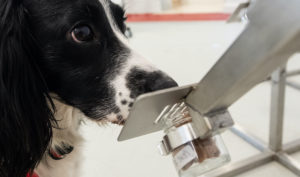
Scholar favors ending unregulated small-volume dog breeding.
Puppies are obedient, loyal, and pure. But their owners may not be so lovable. Irresponsible behavior by dog owners can cause hundreds of thousands of healthy dogs to be put to death each year, according to a recent article by a professor at the University of Georgia School of Law.
That irresponsible behavior—known as backyard breeding—is an amateur form of dog breeding that typically occurs at home, often without regard for a dog’s health. Because backyard breeding typically occurs within private homes, it often goes undetected. It also contributes to pet overpopulation, facilitates dog fighting and gang activity, and burdens consumers with sick puppies.
Unfortunately, existing breeding regulations are not up to the task of controlling the harms from backyard breeding, writes Professor Lisa Milot in her recent article. She proposes a multi-pronged approach to regulating backyard breeding.
Existing dog breeding regulations aim to inhibit mass breeding for commercial purposes and generally do not apply to small-volume breeders. At the federal level, the Animal Welfare Act sets animal treatment standards for research laboratories but exempts breeders that sell to consumers in person as well as businesses breeding fewer than four females.
Similarly, state laws that require commercial pet breeders to obtain licenses ignore small-volume breeders. For example, a 2011 Nevada statute regulating dog breeding restricts puppy mill operators and other commercial breeders but exempts hobby breeders from coverage. Notably, a survey of states with licensing statutes found that almost one-third of the kennel inspectors reportedly made no effort to identify unlicensed breeders.
Furthermore, although some states have local ordinances that regulate small-volume breeding, the lack of uniformity across states prevents effective regulation. Due to the current regulatory patchwork, breeders who do not wish to comply can simply relocate to unregulated regions.
To improve these regulatory efforts, Milot proposes that local animal control departments coordinate enforcement mechanisms with state inspectors.
Milot advises states to adopt legislation requiring all breeders to register in an online database. Such a database would reduce enforcement costs by giving consumers a mechanism to ensure that their purchases are legal. Moreover, the database would allow inspectors to track puppy sales to determine which breeders have exceeded the levels that qualify them for a small-volume exemption. Requiring breeders to register on the database would also encourage backyard breeders to comply with existing business and tax regulations.
Consumers who purchase puppies from small-volume breeders are not protected by “puppy lemon laws,” which provide recourse for the sale of puppies with illnesses or defects. Because these sales are not otherwise purchase-protected, Milot recommends that states require at least a minimum level of veterinary care and a health certificate issued by a veterinarian to accompany each sale.
Milot points out that inadvertent breeders can also contribute to pet overpopulation by leaving their dogs sexually intact. To prevent inadvertent breeding, Milot encourages community groups and activist organizations to reimburse individuals in disadvantaged communities for spaying or neutering their pets.
She notes that, although the sterilization rate for pets in the United States is almost 80 percent nationwide, only about 20 percent of pets in disadvantaged communities are sterilized. In addition to financing these services, Milot suggests that community groups provide educational programs to pet owners who lack knowledge and resources about pet sterilization.
Milot points out that existing resources are not geared towards stopping backyard breeding. For example, the Dog and Cat Sterilization Fund in Georgia distributes grants to rescue groups and shelters, organizations that are already required to spay or neuter their dogs. Instead, Milot proposes that state programs provide resources directly to private owners who are not already subject to the neuter requirement. Distributing resources to such individuals would effectively target needy communities with high rates of backyard breeding, she argues.
Milot reasons that directing resources to backyard breeders rather than to rescue groups and shelters, whose owners are motivated to comply with regulations, would expose criminal breeders. Milot explains that noncompliant breeders, many of whom breed fight dogs and guard dogs, would self-identify by refusing free sterilization. With increased visibility, regulators could target these wrongdoers more efficiently, Milot claims.
Other proponents of backyard breeding regulation go even further than Milot to demand tighter breeding regulation. One such petition calls for tighter laws requiring puppies to be microchipped and de-sexed through ligation, which would preserve the dog’s hormones.
Milot acknowledges that some jurisdictions have adopted “breed-specific legislation” to prevent the use of dogs for criminal activity. Denver’s breed restriction ordinance, for example, prohibits the ownership, possession, transportation, and sale of pit bulls. Milot suspects that this legislation has not achieved its goal, however, because breeders can simply substitute one breed of dog for another.
Milot realizes that enforcement resources are limited. But she contends that by focusing exclusively on the harms associated with large-volume breeders, regulators have overlooked the damage generated by the most culpable breeders. Regulating small-volume breeders and directing resources to those in need would help expose wrongdoers and enhance public safety overall.



